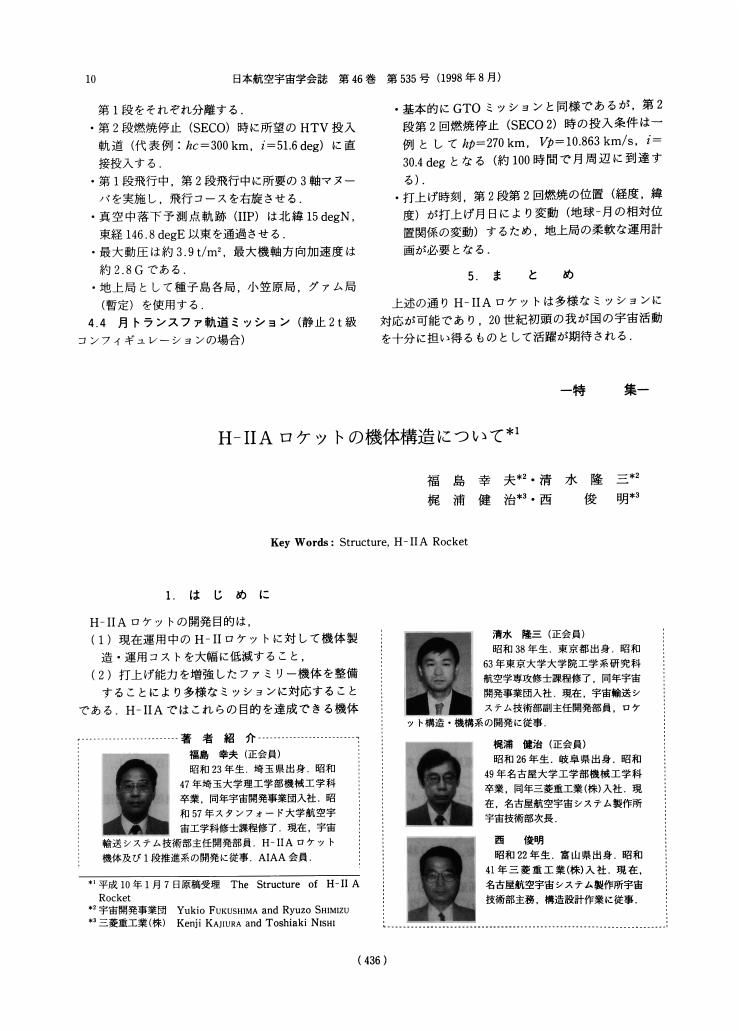2 0 0 0 OA 可変安定応答実験機(VSRA)について(I) VSRAの構成と飛行実験
- 著者
- 古茂田 真幸 川幡 長勝 塚野 雄吉 小野 孝次
- 出版者
- 一般社団法人 日本航空宇宙学会
- 雑誌
- 日本航空宇宙学会誌 (ISSN:00214663)
- 巻号頁・発行日
- vol.31, no.349, pp.75-91, 1983-02-05 (Released:2009-05-25)
- 参考文献数
- 9
- 被引用文献数
- 1 2
2 0 0 0 OA 超音速高等練習機の主翼構造
- 著者
- 小野 伝
- 出版者
- 一般社団法人 日本航空宇宙学会
- 雑誌
- 日本航空宇宙学会誌 (ISSN:00214663)
- 巻号頁・発行日
- vol.21, no.229, pp.83-88, 1973 (Released:2009-05-25)
- 参考文献数
- 10
2 0 0 0 OA コウモリの構造
- 著者
- 名取 通弘 岸本 直子
- 出版者
- 一般社団法人 日本航空宇宙学会
- 雑誌
- 日本航空宇宙学会誌 (ISSN:00214663)
- 巻号頁・発行日
- vol.47, no.551, pp.277-282, 1999-12-05 (Released:2019-04-09)
- 参考文献数
- 15
2 0 0 0 アメリカ人研究者の見た日本の航空宇宙
- 著者
- グラモール カートC.
- 出版者
- 一般社団法人 日本航空宇宙学会
- 雑誌
- 日本航空宇宙学会誌 (ISSN:00214663)
- 巻号頁・発行日
- vol.38, no.442, pp.580-582, 1990
2 0 0 0 OA 東條輝雄さんを偲んで
- 著者
- 西岡 喬
- 出版者
- 一般社団法人 日本航空宇宙学会
- 雑誌
- 日本航空宇宙学会誌 (ISSN:00214663)
- 巻号頁・発行日
- vol.61, no.5, pp.197, 2013-05-05 (Released:2017-06-17)
2 0 0 0 OA 通信衛星2号(CS-2)
- 著者
- 木戸 敬久
- 出版者
- 一般社団法人 日本航空宇宙学会
- 雑誌
- 日本航空宇宙学会誌 (ISSN:00214663)
- 巻号頁・発行日
- vol.32, no.368, pp.491-502, 1984-09-05 (Released:2009-05-25)
2 0 0 0 OA OTVネットワーク 次世代の新しい宇宙輸送システムの概念
- 著者
- 田辺 徹 中須賀 真一 岩田 隆敬
- 出版者
- 一般社団法人 日本航空宇宙学会
- 雑誌
- 日本航空宇宙学会誌 (ISSN:00214663)
- 巻号頁・発行日
- vol.34, no.384, pp.8-17, 1986-01-05 (Released:2009-05-25)
- 参考文献数
- 9
2 0 0 0 OA 発電システムの電子化
- 著者
- 木村 正夫
- 出版者
- 一般社団法人 日本航空宇宙学会
- 雑誌
- 日本航空宇宙学会誌 (ISSN:00214663)
- 巻号頁・発行日
- vol.34, no.388, pp.250-255, 1986-05-05 (Released:2009-05-25)
2 0 0 0 OA H-II Aロケットの機体構造について
- 著者
- 福島 幸夫 清水 隆三 梶浦 健治 西 俊明
- 出版者
- 一般社団法人 日本航空宇宙学会
- 雑誌
- 日本航空宇宙学会誌 (ISSN:00214663)
- 巻号頁・発行日
- vol.46, no.535, pp.436-441, 1998-08-05 (Released:2010-12-16)
- 被引用文献数
- 1
2 0 0 0 宇宙から捉える大きな地震の前駆現象
- 著者
- 小山 孝一郎 児玉 哲哉
- 出版者
- 一般社団法人 日本航空宇宙学会
- 雑誌
- 日本航空宇宙学会誌 (ISSN:00214663)
- 巻号頁・発行日
- vol.65, no.6, pp.178-184, 2017-06-05 (Released:2017-06-05)
- 参考文献数
- 21
日本の“ひのとり”,およびフランスの“DEMETER”衛星により得られた電子密度,米国の“DE-2”および“DMSP”衛星により得られた酸素原子イオン密度のデータ解析から見出された大きな地震(M>7)の前駆現象を紹介する.大きな地震発生数日前に見られることのある電離圏擾乱は,経度方向に約80度,緯度方向に約40度の広がりを持つ.電離圏の振る舞いは観測時の地方時,観測高度,震源の緯度,および震源からの距離により異なった様子を見せる.衛星高度が高い(高度300 km以上)と,震源上空で擾乱が見られるとは限らず,日本北部で発生した大きな地震では震源の北上空および磁気赤道上空の電離圏にも擾乱が観測された.震源の緯度,経度を同定するには,衛星高度は約300 km以下である必要がある.電離圏擾乱を引き起こす機構についてはいくつか提案されているが,ここでは大気力学との関連について簡単に議論する.地震により引き起こされた電離圏擾乱の機構を探るには,電子密度・温度測定器を搭載した複数個の超小型衛星とプラズマドリフト測定器などを搭載した小型衛星による観測計画が望まれる.
2 0 0 0 OA 炭化水素ロケット燃焼器の高圧燃焼
- 著者
- 田村 洋
- 出版者
- 一般社団法人 日本航空宇宙学会
- 雑誌
- 日本航空宇宙学会誌 (ISSN:00214663)
- 巻号頁・発行日
- vol.37, no.427, pp.386-393, 1989-08-05 (Released:2010-12-16)
- 参考文献数
- 13
- 著者
- 運輸省全日空機接触事故調査委員会
- 出版者
- 一般社団法人 日本航空宇宙学会
- 雑誌
- 日本航空宇宙学会誌 (ISSN:00214663)
- 巻号頁・発行日
- vol.21, no.237, pp.624-640, 1973
2 0 0 0 SS-520 5号機 機体システム開発概要
- 著者
- 大塚 浩仁 佐野 成寿 羽生 宏人 山本 高行 伊藤 琢博 岩倉 定雄
- 出版者
- 一般社団法人 日本航空宇宙学会
- 雑誌
- 日本航空宇宙学会誌 (ISSN:00214663)
- 巻号頁・発行日
- vol.68, no.2, pp.32-37, 2020-02-05 (Released:2020-02-05)
- 参考文献数
- 4
本解説では,超小型衛星打上げ機(SS-520 4,5号機)の機体システム開発の概要を示す.本ロケットの開発意義は,搭載した宇宙用機器に品質の高い民生部品を活用して超小型衛星打上げシステムを作り上げたことと,従来の開発手法に加え新たに取り組んだ民生品の品質保証の考え方を構築してフライト実証したことである.また,既存の観測ロケットに衛星打上げ能力を持たせるためには,いくつかの課題を克服する必要があった.抜本的な構造軽量化,搭載機器の小型軽量化,衛星とロケット一体となった機能の最適配分,誘導制御系の工夫,飛行安全,Test as Flyをベースとした検証試験等々,限られたリソースと開発期間の厳しい制約条件のなかで随所に創意工夫を施した.本解説では,その開発におけるポイントを総括した.
2 0 0 0 OA Peaky翼型について
- 著者
- 佐藤 淳造
- 出版者
- 一般社団法人 日本航空宇宙学会
- 雑誌
- 日本航空宇宙学会誌 (ISSN:00214663)
- 巻号頁・発行日
- vol.18, no.201, pp.374-388, 1970 (Released:2010-01-13)
- 参考文献数
- 99
- 著者
- 河合 宗司
- 出版者
- 一般社団法人 日本航空宇宙学会
- 雑誌
- 日本航空宇宙学会誌 (ISSN:00214663)
- 巻号頁・発行日
- vol.61, no.7, pp.253-255, 2013-07-05 (Released:2017-12-27)
- 参考文献数
- 1
2 0 0 0 第7回探査ミッション立案スクール“太陽系探査”に参加して
- 著者
- 田中 寛人
- 出版者
- 一般社団法人 日本航空宇宙学会
- 雑誌
- 日本航空宇宙学会誌 (ISSN:00214663)
- 巻号頁・発行日
- vol.67, no.7, pp.265-266, 2019-07-05 (Released:2019-07-05)
- 参考文献数
- 3
2 0 0 0 OA 最短時間旋回に関する-覚書
- 著者
- 大林 和弘 加藤 寛一郎
- 出版者
- 一般社団法人 日本航空宇宙学会
- 雑誌
- 日本航空宇宙学会誌 (ISSN:00214663)
- 巻号頁・発行日
- vol.36, no.416, pp.433-439, 1988-09-05 (Released:2010-12-16)
- 参考文献数
- 4
Three-dimensional minimum-time turns are formulated and solved numerically as optimal control problems. The formulation covers the drag increase and the lift decrease due to sideslip. Inequality constraints are used to simulate the upper and lower bounds of thrust, angle of attack, sideslip and load factor. A state-variable constraint is included to treat the flight sustaining the corner velocity. Numerical results explain the effect of thrust, sideslip and initial velocity in optimal maneuvers.
2 0 0 0 OA 貯蔵性推進剤の2段燃焼サイクルに関する検討
- 著者
- 若松 義男 冠 昭夫 毛呂 明夫
- 出版者
- 一般社団法人 日本航空宇宙学会
- 雑誌
- 日本航空宇宙学会誌 (ISSN:00214663)
- 巻号頁・発行日
- vol.33, no.373, pp.68-75, 1985-02-05 (Released:2009-05-25)
- 参考文献数
- 12
2 0 0 0 OA 展望―巨大ロケット機体に及ぼす空力影響
- 著者
- 井川 日出男
- 出版者
- 一般社団法人 日本航空宇宙学会
- 雑誌
- 日本航空宇宙学会誌 (ISSN:00214663)
- 巻号頁・発行日
- vol.28, no.323, pp.569-577, 1980-12-05 (Released:2009-05-25)
- 参考文献数
- 3
2 0 0 0 OA 赤外線によるロケットの姿勢検出
- 著者
- 豊田 実 石堂 正弘 飯野 博司
- 出版者
- 一般社団法人 日本航空宇宙学会
- 雑誌
- 日本航空宇宙学会誌 (ISSN:00214663)
- 巻号頁・発行日
- vol.24, no.265, pp.85-94, 1976-02-05 (Released:2009-05-25)
- 参考文献数
- 5
The attitude of a rocket is determined by two kinds of angle which are formed between the axis of a rocket and two standard lines. The one is a pitch angle, and the other is a yaw angle.In this paper, the method of the design of a horizon sensor device to determine a pitch angle, the observed results using it and the discussion on them are reported.The output of this device is remarkably affected by the several factors such as the time constant of a sensor, the altitude and the attitude of a rocket and the setting angle of a sensor for a rocket. So that, making these factors as parameters, the method of the design for the optical system and the amplifier of this device were studied.Two horizon sensor devices designed based on these results were boarded on the rocket L-3H7 and the rocket K-10-10 respectively. The observed results by these two devices gave not only the pitch angles of two rockets, but also the temperature distribution of the earth from which the yaw angles were gained.













